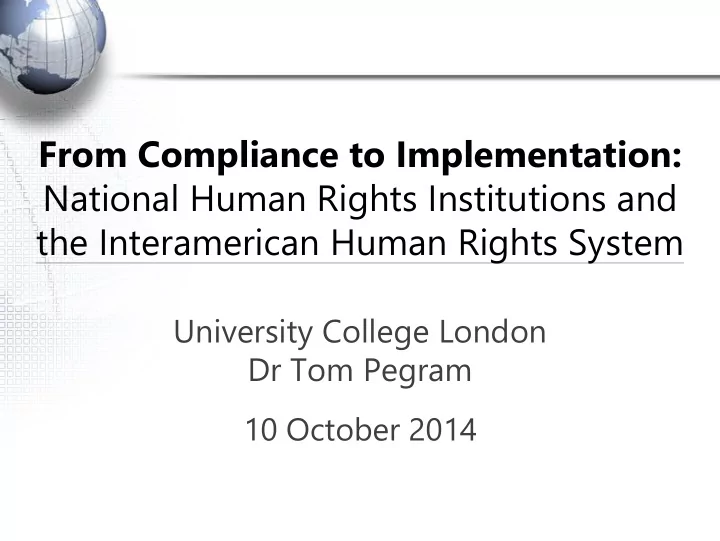

From Compliance to Implementation: National Human Rights Institutions and the Interamerican Human Rights System University College London Dr Tom Pegram 10 October 2014
The IAHRS and the Implementation Gap • Shift in focus from rule- making to rule- compliance • Linkages between international and domestic levels remain theoretically under-specified o Human rights “from above” o Rule contestation and conflict at local level • Bottom- up accounts of the effects of int’l human rights instruments • Spotlight on sub-state actors • Importance of local contextual reality
Year Country Nomenclature created Guatemala 1985 National Human Rights Prosecutor Mexico 1990 National Commission of Human Rights Honduras 1990 Commissioner for the Protection of Human Rights Colombia 1991 National Human Rights Ombudsman El Salvador 1991 National Human Rights Prosecutor Costa Rica 1992 National Human Rights Ombudsman Paraguay 1992 National Human Rights Ombudsman Argentina 1993 National Human Rights Ombudsman Peru 1993 National Human Rights Ombudsman Bolivia 1994 National Human Rights Ombudsman Nicaragua 1995 Commissioner for the Protection of Human Rights Ecuador 1996 National Human Rights Ombudsman Panama 1996 National Human Rights Ombudsman Venezuela 1999 National Human Rights Ombudsman Chile 2009 National Human Rights Institute Uruguay 2011 National Human Rights Institution
National human rights institutions (NHRIs) • Formally independent, state-funded, national agencies mandated to protect human rights o Defensorías del Pueblo y Comisiones Nacionales de Derechos Humanos or Human Rights Ombudsmen • Shift in focus to: o Domestic compliance constituents (Dai 2005) o Implementation partners (Open Justice 2013) o Local rights stakeholders (Hafner-Burton 2013) • Bridging IR and comparative politics: o Horizontal accountability agencies (O’Donnell 1998) o Social accountability (Peruzzotti & Smulovitz 2006) o Coalitions-formation: Reformers in the state bureaucracy and CSOs (Fox 2007)
NHRI engagement with the IAHRS • Article 25(1) right to judicial protection o Legal prerogatives of NHRIs: amparo and habeas • OAS Assembly o OAS electoral missions o Ideational and material support • Interamerican Commission on Human Rights o Petition powers on behalf of individuals and groups o Participation in review of admissibility o Monitoring of friendly settlements • Interamerican Court of Human Rights o No formal framework for NHRI participation o Nevertheless, played multiple roles o Well placed to monitor implementation
Value-added of NHRI engagement • Facilitate access o Individual protection and class action submissions o NHRIs as integrants of new Interamerican Public Defender • Informational conduits o Expert witness to IACtHR proceedings o Fact-finding (special reports as documentary evidence) o Amicus curiae submissions o El Salvador: Hermanas Serrano Cruz. Vs. El Salvador • Urgent actions (provisional measures) o Providing recourse to individuals under threat • Compliance and reparation mechanism o NHRI legal petitions 4% of the total, but compliance rate of 71.4 % compared to average of 35.7%
Indirect human rights accountability through orchestration (Abbott & Snidal 2014)
HRO-specific hypotheses HRO-specific HROs are more likely to orchestrate with hypotheses IAHRS when: There is divergence of goals among government Goal divergence actors and/or between the HRO and government Government principals have weak institutional State oversight control mechanisms Engagement with Cooperation is developed, formalized and International bodies maintained with the IAHRS Intermediary CSO intermediaries with correlated goals and availability complementary capabilities are available Focality HRO is the national focal actor in human rights Local salience of IAHRS norms resonate in local context and are issue-area norms responsive to specificities (“vernacularization”)
HRO-specific hypotheses HRO-specific HROs are more likely to orchestrate with hypotheses IAHRS when: Guatemala: January 2014 the government sought Goal divergence to restrict IACtHR jurisdiction pre-1987 Mexico: CNDH is restricted by law in its ability to State oversight litigate before the IACtHR (but not the CDHDF)* Engagement with Ecuador & Peru: The IACtHR has entered into International bodies Agreements of Cooperation with these NHRIs Intermediary El Salvador: NHRIs rarely engage without CSO availability CR: CEJIL invitation rejected by NHRI Argentina: the focal actor engaging with the Focality IAHRS is the Defensoría General Local salience of Guatemala & Peru: death penalty advocacy at issue-area norms national level (anti-populist position)
HRO-specific hypotheses applied to Colombia HRO-specific HROs are more likely to orchestrate with hypotheses IAHRS when: Divergence pronounced under leadership of Goal divergence Cifuentes (00-03) e.g. Urabá No formal restriction on engagement with IAHRS. State oversight Presidential role in appointment of Defensor Engagement with Interaction ad hoc, no agreement. However, early International bodies engagement (public audiences by Triviño (93-96) Intermediary 1992: NHRI worked with NGOs on case of availability massacre in Trujillo to arrive at friendly settlement Focality diminished significantly 2003; Volmar Focality Perez de-prioritized engagement with IAHRS Local salience of Thematic resonance: violence against women in issue-area norms conflict; transitional justice. But highly politicized.
HRO-specific hypotheses applied to Peru HRO-specific HROs are more likely to orchestrate with hypotheses IAHRS when: Combative relationship btw Defensoría & gov’t Goal divergence pre and post-transition in 2000 No formal restrictions. Janet Espinoza case (2002) State oversight confirmed NHRI standing before IACtHR Engagement with Formal cooperation agreement signed with the International bodies IACtHR (but “general attitude of indifference”) Active collaboration between Defensoría & CSOs. Intermediary 2001: joint petition by DP and Movimiento availability Manuela Ramos re: women voting rights Defensoría del Pueblo is the national focal actor in Focality human rights (OAS mission: 2000) Local salience of Important impact on process of transitional issue-area norms justice. Highly politicized, growing obstruction
HRO-specific hypotheses applied to Peru HRO-specific HROs are more likely to orchestrate with hypotheses IAHRS when: There is goal convergence among government Goal divergence actors and/or between the HRO and government No formal restrictions. Janet Espinoza case (2002) State oversight confirmed NHRI standing before IACtHR Engagement with Formal cooperation agreement signed with the International bodies IACtHR (but “general attitude of indifference”) Active collaboration between Defensoría & CSOs. Intermediary 2001: joint petition by DP and Movimiento availability Manuela Ramos re: women voting rights Defensoría del Pueblo is the national focal actor in Focality human rights (OAS mission: 2000) Local salience of Important impact on process of transitional issue-area norms justice. Highly politicized, growing obstruction
Recommend
More recommend